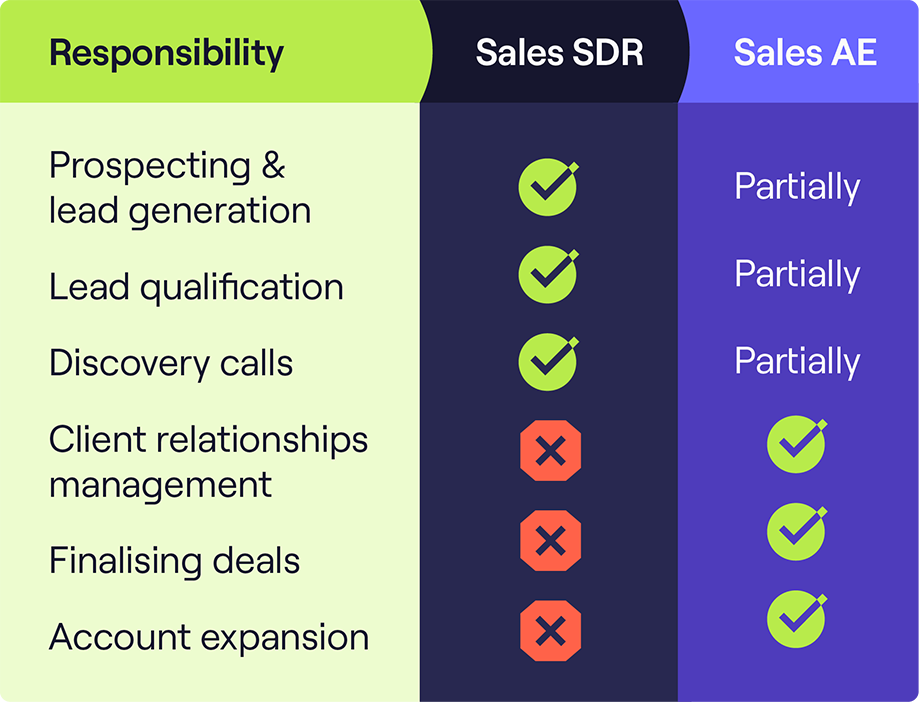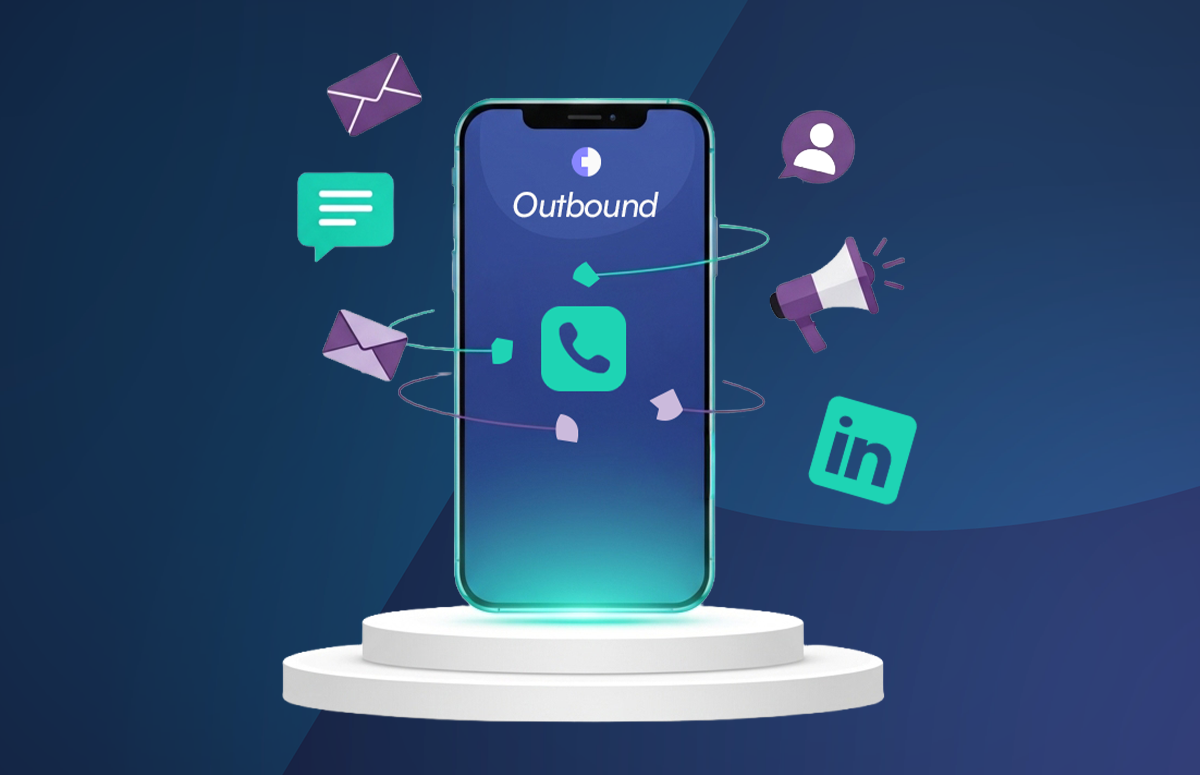AE Sales: Tips and Strategies for Winning Deals
Experienced account executives are the central pillars of successful client relationships, facilitating business growth through meaningful connections and deal closures.
However, the responsibilities of AEs often overlap with those of other sales roles. The question is: what truly sets AE sales apart?
In this article, you’ll learn about the core responsibilities of AEs, so you know how they differ from SDRs and how they can excel in their roles.
Let’s start 👇
What is an AE in Sales?
An account executive (AE) is a salesperson primarily responsible for maintaining a long-term business relationship with a customer. AEs have extensive knowledge of a company’s objectives, products, and solutions so they can maintain and enhance customer relationships over time.
A sales AE aims to ensure that a client understands a product or service’s value, identifies new client needs and suggests solutions to improve their overall buyer experience.
What’s the difference between an SDR and an AE?
The primary role of an SDR is generating leads through outbound sales strategies. SDRs usually source email lists, find prospects on LinkedIn, and do all the heavy lifting related to nurturing leads and leading them to the first call.
An SDR can then pass a lead to an AE. In most cases, however, AE sales reps are more engaged in negotiating and signing contract conditions with clients.
Now that you’ve got a rough idea of both roles let’s compare the responsibilities of SDRs and AEs:

AE sales and SDR sales shouldn’t be siloed. The better each AE or SDR are at their roles, the easier it is for the other.
It’s in the best interests of the AEs to support the growth and development of upcoming SDRs; it helps them to hit their targets while at the same time shaping the next influx of AEs coming up the ranks.
This is what the AE-SDR workflow looks like at Cognism:

The anatomy of a good relationship between an AE and an SDR is often the same as any other healthy, strong relationship.
It relies on regular, honest communication. The opportunity for open conversations, the ability to ask questions, provide constructive feedback, offer advice and be there to listen when issues arise.
Both parties need to be willing to work hard for the other. They need to put time and effort into making the next steps of the B2B sales process easier for their counterpart.
What is the role of an account executive in sales?
The role of an AE in sales is to manage and nurture relationships with potential and existing customers to drive revenue and business growth.
AEs are responsible for the entire sales process, from prospecting and lead generation to closing deals and ensuring customer satisfaction. Their primary focus is building strong client relationships, understanding customer needs, and presenting solutions that meet them.
|
Prospecting and lead generation |
Identify and qualify potential customers through cold calling, email outreach, networking, and leveraging marketing-generated leads. |
|
Presenting solutions |
Deliver compelling sales presentations highlighting how your product or service can address specific problems and deliver value. |
|
Negotiation and closing |
Negotiate contract terms, pricing, and other aspects of the deal, with the ultimate goal of closing the sale and securing a commitment from the customer. |
|
Building relationships |
Establish and maintain strong relationships with clients, acting as a primary point of contact for any questions or concerns. |
|
Account expansion |
Look for opportunities to upsell or cross-sell additional products or services to existing customers, driving account expansion and increasing customer lifetime value. |
|
Customer success |
Ensure that customers are satisfied with their purchase and receive the support they need, maintaining open lines of communication and addressing any issues that arise. |
|
Market intelligence |
Stay updated on industry trends, competitor activities, and customer feedback to continuously improve their sales strategies and offerings. |
To sum up, AE sales are crucial to an organisation’s success. They bridge the gap between the company’s products or services and the customer’s needs.
If there was one word to describe an account executive, it would be “catalysts”, creating B2B sales opportunities from new and existing accounts.
Top strategies for AE sales (with sample scripts)
It’s important to empower AEs for a strong sales cycle. By implementing these simple strategies, every AE can become comfortable in achieving their sales goals:
1. Practice active listening
AEs should actively listen to their prospects during discovery calls and understand their pain points, challenges, and goals.
When having calls with prospects or customers, it’s important to personalise a pitch to the client’s unique challenges and needs. Here is an example of a script every AE can use to understand customer needs better.
AE: Thank you for taking the time to speak with me, (Prospect’s Name). I’d like to fully understand your requirements. Please share more about the challenges you’re facing and the goals you want to achieve.
2. Responding promptly
The best AEs answer prospect queries and follow up on promised actions. Showing a proactive approach and dedicating more attention to a prospect builds trust.
When nurturing multiple accounts, for some AEs, keeping up with communication can become a challenge. Still, you can solve it by implementing processes around communication’s best practices, setting up notifications, and automating messages where possible.
While sales automation can free up lots of time, remember to balance automation with a personal touch.
3. Be diligent with follow-ups
Follow-ups are crucial after meetings and calls. Especially in AE tech sales - you must stay engaged with prospects, address additional questions or concerns, and provide the information they need to move forward.
Here’s how you can do it in a conversation:
Hi (Prospect’s Name),
I hope you’re doing great! I’m checking in to see if you have any thoughts about our (Product/Service) and how it aligns with your needs.
I’m here to assist if you’re ready to take the next step or have any questions. Let’s schedule a quick call to address any outstanding matters.
Looking forward to connecting soon.
Best regards,
(Your Name)
4. Build trust and rapport
Establishing trust with your prospects is essential for successful AE sales. Account executives should be genuine, transparent, and reliable in their interactions.
Building rapport helps prospects feel comfortable and confident in making a purchase. It’s not that difficult. Next time, follow this cold calling script:
AE: It’s a pleasure to connect with you, (Prospect’s Name). Before we delve into the details, I’d love to learn more about your organisation and specific needs.
Could you share your current operations and what you want to achieve?
5. Leverage testimonials and case studies
Use customer testimonials and case studies to showcase successful implementations and positive outcomes.
Social proof can be a powerful tool in building credibility and trust with potential customers.
6. Focus on value, not price
Emphasise your product’s value and benefits, rather than competing solely on price. Show how your offering can solve their problems and provide a positive return on investment. Here’s an example:
AE: Thank you for considering our (Product/Service), (Prospect’s Name). I understand that cost is crucial, and we strive to provide the best value for your investment.
Our solution addresses (prospect’s pain point/goal), ensuring you achieve (specific outcomes). By implementing our (Product/Service), you’ll experience (key benefits), leading to significant savings in (relevant areas) and a positive impact on your overall efficiency and growth.
Our customers have consistently reported (mention success stories/testimonials), validating the value we deliver.
Let’s focus on how our solution can precisely meet your needs and unlock long-term benefits rather than merely competing on price.
7. Stay informed
Keep yourself updated about industry trends, news, and changes that could impact your prospect’s business; being knowledgeable positions you as a valuable resource.
It’s also worth following the news about your clients’ and prospects’ companies. Stay informed about changes in the company structure and any promotions.
These changes are great sales triggers to send an email to clients, establish a discussion, and get a chance to pitch your products.
8. Overcome objections
Anticipate and address common objections your prospects may raise during the sales process.
Be prepared with thoughtful responses demonstrating your expertise and how your solution can overcome their concerns.
Script example:
AE: Before we proceed, I’d like to understand your current options. Please tell me which competitors or solutions you are considering for (prospect’s pain point/goal).
9. Collaborate with marketing
Work closely with your B2B marketing team to ensure your sales collateral, messaging, and content align with the needs of your target audience.
Consistent and compelling marketing materials support your sales efforts.
10. Create a sense of urgency
Encourage prospects to act quickly by highlighting limited-time offers, promotions, or other incentives. Creating a sense of urgency can motivate prospects to decide rather than procrastinate.
Use this script:
AE: Time is of the essence, (Prospect’s Name). Our (Product/Service) is currently in high demand, and we have limited availability due to its popularity.
Additionally, we’re running a special promotion exclusively for new clients, offering (mention exclusive benefits or discounts).
However, this offer is time-sensitive and will expire in (mention the time frame). By taking advantage of this opportunity now, you can secure (mention advantages).
Let’s act quickly to ensure you can start seeing (include benefits) from our (Product/Service) as soon as possible.
13. Use success stories
Share success stories of how your product/service has benefited other clients, especially those in a similar industry or with comparable challenges. Try to personalise the case studies based on the sector or client size.
This way, you’ll quickly build trust and show your expertise.
14. Be a consultant
Position yourself as a consultant rather than a pushy salesperson. Offer insights and guidance based on your expertise to help the prospect make an informed decision.
15. Know your competition
Be aware of your competitors and how your product or service differentiates itself. Understanding the strengths and weaknesses of your competitors is an essential AE sales strategy. It can help you articulate why your solution is superior.
Here’s how you can do it in a conversation with a prospect:
AE: Before we proceed, I’m interested to know if you’ve explored any other options in the market. Have you considered or are you currently looking into any competitors or alternatives to address (prospect’s pain point/goal)?
16. Celebrate customer success
Finally, acknowledge and celebrate your customers’ successes! Their achievements with your product or service can reinforce the value you bring and lead to referrals.
This opens the door to new opportunities and account expansion.
Better sales with Cognism
You’ll accomplish better AE sales with the right sales data.
Cognism's Sales Companion gives you the data that matters most to you. It helps you prioritise your time with leads and insights tailored to your target territories. Plus, you get:
- Fresh, quality Signal Data delivered daily.
- Intent data to cut down on wasted effort and increase ROI.
- Phone-verified mobile numbers to reach decision-makers without having to run through a list of wrong numbers.
- Sales Companion delivers personalised outreach with contact-specific data that ensures every interaction drives results.
- And more!
%20Hub/Headshots/johnny-stiffell-headshot.webp)



